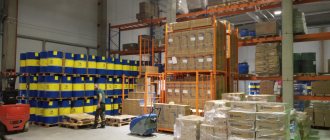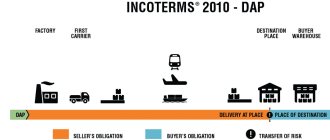If previously the safety of the cargo was taken care of directly by its owners, and logistics companies only rented out the warehouse, today, when sending goods to a temporary storage warehouse (TSW), you can be sure of its complete safety. Responsibility for safety falls on the logistics company. Unlike renting a temporary storage warehouse, during storage you can split up the batches and remove them in parts. The service is popular among companies that need to store products from time to time and do not have their own equipped warehouses for this. It is much cheaper to store products in the warehouses of a third-party company, as opposed to building, equipping and maintaining your own warehouse.
Temporary storage warehouse - temporary storage warehouse
Temporary storage warehouse or temporary storage warehouse TT is an abbreviation for the name “customs terminal temporary storage warehouse”.
A temporary storage warehouse is a special room or territory in the customs control zone equipped for the temporary storage of goods and vehicles moving across the border. On the territory of the temporary storage warehouse, customs clearance of goods imported into the country takes place.
The customs control zone (CZZ) is the territory where transhipment, weighing, inspection and inspection, customs clearance, responsible storage of your goods and other operational activities take place under the strict control of customs. Customs control zones can be not only on the territory of the temporary storage warehouse. This may also be a section along the border and other places determined by the Customs Code of the Russian Federation.
When the goods cross the border, the cargo space of the vehicle with the goods imported into the country is sealed and after passing the border checkpoint, the transport with the cargo goes to the customs control zone to a temporary storage warehouse (TSW) for customs clearance. Cargo and transport are temporarily located on the territory of the temporary storage warehouse from the moment they are presented to customs until the end of customs clearance and release.
Temporary storage equipment
Now we will consider a number of requirements established for the equipment of temporary storage warehouses: - if it is planned to use the warehouse both as a temporary storage warehouse and as a customs warehouse, then the temporary storage warehouse premises must be equipped with all the necessary access roads, these parts must be isolated and have appropriate fences; - the warehouse must be equipped with all the necessary means and equipment intended for customs control of fissile and radioactive materials.
The type of such technical means is determined by the Federal Customs Service of Russia, and the amount of necessary equipment is established by the customs authority, on the basis of technical regulations and standards; — equipping the warehouse with the necessary X-ray inspection equipment, the quantity and type of such equipment is determined by the customs authority; — the local network operating in the warehouse must contain a dedicated segment intended for the work of customs officers who carry out customs clearance and control of goods; — the warehouse must be equipped with weighing equipment that ensures weighing of goods with different weighing limits; — all necessary means of telephone and fax communication, copying equipment and other office equipment; — the warehouse must be equipped with an automated accounting system for stored goods, such an accounting system must be among those permitted for use by customs authorities; — the presence of equipment that ensures the processes of loading and unloading goods (forklifts, electric forklifts, etc.) is required; the equipment must be present in quantities that ensure the processes of customs control of goods; — an electronic system for placement and accounting of goods, compatible with the software of customs authorities, allowing for control of goods in real time.
Customs clearance “from wheels”
“From the wheels” is a slang name for the customs clearance procedure, when all goods in the cargo compartment are cleared without unloading from the vehicle. This procedure is especially effective during customs clearance of a consignment of consolidated cargo, when the cargo compartment contains goods from different customers.
Cars with goods that pass customs “from the wheels” are also parked at the temporary storage warehouse.
Registration “on wheels” significantly saves time and money, since there are no additional costs for loading and unloading operations (LOW) and storage of goods at a temporary storage warehouse. In the case of groupage cargo, the costs of temporary storage warehouses are evenly distributed among all orders.
In the case of transportation of consolidated cargo, goods with which difficulties arose during customs clearance can be unloaded from the vehicle in order not to delay the cargo of other customers.
The temporary storage warehouse charges an additional fee for processing and storage of goods, in accordance with its tariffs.
The priority task that the Eride.ru team sets for itself is to process our clients’ cargo “on wheels” in order to optimize costs and delivery times.
Registration of documents and permits
To attract regular customers to your warehouse, you need to officially register your business. Individual entrepreneurs and LLCs are equally suitable for this work; the choice remains with the warehouse owner. Registration is required not only for paying taxes: potential clients are ready to trust their property exclusively to reliable partners, preferably legal entities. The work will be carried out under a contract.
In addition to the registration certificate, you will have to obtain other permits. Their specifics depend on the type of warehouse and what products are planned to be stored. For example, a food warehouse must be inspected by Rospotrebnadzor and SES, which will confirm compliance with storage conditions. Any of the warehouses will have to undergo an inspection by the Ministry of Emergency Situations or the fire inspection, without a positive conclusion from which cargo will not be stored.
Drawing of a one-story hangar-type warehouse
How much do temporary storage warehouse services cost and what does it include?
Entrance to the territory of the temporary storage warehouse and parking
The cost of entry to the territory of a temporary storage warehouse in Russia ranges from four to seven thousand rubles. For this money you get the following services:
- printout of confirmation of arrival at customs for the driver;
- acceptance of shipping documents from the driver and their transfer to the customs authority;
- parking in the open area for 24 hours from the moment of arrival.
2. Loading and unloading operations and storage at a temporary storage warehouse
If a truck transports goods from several customers and customs clearance takes place at different terminals, then there is a need to unload and store goods in a temporary storage facility.
This event is associated with additional costs that will need to be added to the fee for travel of vehicles to the territory of the ZTK. As a rule, we are talking about an amount from five to fifteen thousand rubles for cargo placed on several pallets with an average customs clearance cycle of three working days.
After customs releases the goods for free circulation, you will need to take them to your warehouse.
Detailed tariffs for temporary storage warehouse services
It is best to request the exact cost of services from the temporary storage warehouse itself or check with your customs representative. Below is an example of a price list with the cost of services from one of the temporary storage warehouses.
List of necessary documentation for acceptance of cargo at the temporary storage warehouse
To place the goods, the owner will need to prepare the following documents:
- Information about the name, location of the sender/recipient. The information must agree with the data specified in the transport documentation.
- Information about countries (sending, receiving).
- Product type, quantity, purpose.
- Labeling, packaging.
- Invoice cost.
- Weight, volume.
- Codes of commodity nomenclature of foreign trade activities.
| Name of service | Unit of measurement (per day) | Cost of services |
| Storage of goods and materials in pallets (max. parameters: length - 120 cm, width - 80 cm, height - 180 cm (with pallet) up to 1 ton. | pallet space or m3 | from 12 rub. cold storage, from 22 rub. warm warehouse |
| Storage of oversized goods (if one of the dimensions and weight indicators (DSHV or weight) of one accounting unit exceeds the parameters of a pallet space, then it is an oversized product). | m3 | from 15 rub. |
| Outdoor storage (sq.m. day) | m3 | 10 rub. |
| Storage of inventory items in an open area under a gantry crane (24 hours) | m3 | 12 rub. |
| Storage in warehouse areas including unloading, in-warehouse processing (selection of goods and materials by names, articles, positions), loading of goods and materials | pallet space or m3 (from 20 pallets) | 25 rub. cold warehouse, 35 rub. warm warehouse |
| Storage of dangerous goods (calculation individually) | pallet space or m3 | from 30 rub. |
Cargo handling:
| Unloading and loading of goods and materials | |
| Name of service | Price per one. |
| Mechanical unloading of palletized goods and materials into a warehouse | 125 rub. pallet up to 1.2 tons |
| Manual unloading of goods and materials into a warehouse (place, box, packaging weighing from 1 to 15 kg.) | 10 rub. box, packaging |
| Manual unloading to the warehouse (place, box, packaging weighing from 15 to 50 kg.) | 20 rub. box, packaging |
| Manual unloading to the warehouse (place, box, packaging weighing over 50 kg) | 135 rub. box, packaging |
| Manual unloading to the warehouse (piece weighing up to 1 kg.) | 3 rub. for one piece |
| Unloading oversized cargo (sum of measurements more than 1201*1201*2001mm) | 180 rub. for one cubic meter |
| Cross-docking or “reloading”, “cargo processing”. Mechanical reloading from vehicle to vehicle (container) | 180 rub. pallet up to 1.2 tons |
| Manual reloading from vehicle to vehicle (place, box, package weighing from 1 to 15 kg.) | 12 rub. per piece, box, packaging |
| Manual reloading from vehicle to vehicle (place, box, package weighing from 15 to 50 kg.) | 22 rub. for 1 place, box, packaging |
| Manual reloading from vehicle to vehicle (place, box, package weighing over 50 kg) | 135 rub. for 1 place, box, packaging |
| Manual reloading from vehicle to vehicle (piece weighing up to 1 kg.) | 3 rub. for one piece |
Additional services:
| Providing a railway dead-end on the territory (access to railway tracks, delivery, crediting of a car). | 18500 rub. |
| Palletizing (manual, 2-3 layers) of goods and materials on a formed pallet with stretch film (including consumables) | 90 rub. pallet |
| Pallet (pallet) of special strength | 320 rub. |
| Collection and removal of waste (MSW) with subsequent disposal | 550 rub. m3 |
| Sealing (including consumables) | 50 rub. For 1 operation |
| Weighing | 60 rub. pallet |
| Weighing (place, box, packaging, bag) | 20 rub. 1 piece, box, packaging, bag |
| Weighing of goods and materials (items weighing up to 1 kg.) | 3 rub. for one piece |
| Strapping, strengthening of goods and materials on a formed pallet with plastic tape (including consumables) | 100 rub. pallet |
| Laying goods and materials with a cardboard sheet (size 800x1200 mm) | 30 rub. for one sheet |
| Mechanical stitching of a damaged bag (including consumables) | 10 rub. for one bag |
| In-package processing, bulkhead of goods and materials (place, box, packaging, bag) | From 15 rub. for one place, box, packaging, bag |
| Sticking, marking of goods and materials (in case of provision of consumables by the Depositor) | 5 rubles per operation |
| Printing of stickers, packing lists (if consumables are provided by the Depositor) | 3 rub. for one piece |
| Scotch tape (processing with adhesive tape, including consumables) | 20 rubles for 1 piece, box, packaging |
| Removing a label (sticker) | 6 rub. for one piece |
| Lathing, additional packaging of goods and materials | (On agreement of the parties) |
| Registration of the package of accompanying documentation provided by the Bailor | 100 rub. for processing one shipment. |
| Transport services (Gazelle up to 1.5 t, 9m3) | 3000 rub. minimum salary 4+1 Moscow and up to 10 km beyond the Moscow Ring Road |
| Transport services (Gazelle up to 1.5 t, 9m3) | 600 rub. for every hour over the minimum wage |
| Transport services (Gazelle up to 1.5 t, 9m3) | 20 rub. per kilometer starting from 11 km from the Moscow Ring Road (mileage in both directions is taken into account) |
| Transshipment of oversized cargo | forklift – 11,000 rubles, crane – 17,500 rubles. |
Insulation of containers for transporting goods.
| CPC insulation services: | ||
| Type of work | 20-ft. CPC | 40-ft. CPC |
| Single-layer insulation (50 mm) without film | RUB 13,400 | 20,000 rub. |
| Single-layer insulation (50 mm) with film | 15,400 rub. | 23,000 rub. |
| Single-layer insulation (100 mm) without film | 17,300 rub. | 28,000 rub. |
| Single-layer insulation (100 mm) with film | 19,300 rub. | 31,000 rub. |
| Two-layer insulation (150 mm) without film | RUB 25,100 | 38,000 rub. |
| Two-layer insulation (150 mm) with film | RUB 27,100 | 41,000 rub. |
Terminals without long-term storage capabilities
It is worth paying special attention to the fact that there are customs terminals that are not equipped with warehouse space for long-term storage of goods and maintaining proper temperature conditions. In these places, there is usually a designated area for unloading for inspection under a canopy or in an unheated room using outdoor scales.
If the goods are sensitive to temperature changes, then you must check with the customs broker in advance the storage conditions in case of unloading to a temporary storage warehouse.
Consider market needs
When determining a location for building a warehouse, find out several important questions:
- What goods will the warehouse be used for?
- Is there a need to store this particular product?
- What kind of warehouse will it be: seasonal, reserve, production, wholesale, retail or general use.
- Make a list of future tenants and business partners.
In your marketing plan, indicate the average rental price for similar premises. When determining your price, consider warehouses larger or equal in size to yours, as smaller facilities will not be able to compete equally. Analyze how the market will develop in the near future to calculate the effectiveness of the project.
Advertising services
This category of services belongs to the B2B sphere, that is, “business to business”. The warehouse's clients will be entrepreneurs, small and medium-sized companies. Their goal is to save money on building their own warehouse, store raw materials and resources in reliable conditions. The warehouse owner should take these factors into account when planning advertising.
The best source of regular users will be sending commercial offers. Prepare a database of potential clients and send them an email presenting your business:
- warehouse address;
- interior photographs;
- list of equipment useful to the client (loaders, conveyors);
- conditions and cost of cooperation.
Outdoor advertising will be no less useful - billboards, posters, banners, posters and light boxes. Thousands of people pay attention to them every day, and there will definitely be potential clients among them. There is only one drawback - high cost. The same can be said about advertising on TV and radio. It brings many clients, but is expensive for the entrepreneur.
A good option, optimal in terms of efficiency and cost, is to promote through social networks. Most companies maintain business accounts there and look for clients and partners through them. You can register an account completely free of charge, and promote it for free or with a small investment. Subscribe to all potential clients on Instagram and VKontakte, send them messages with commercial offers, not forgetting to publish up-to-date information about your services and promotions.
Even with a small budget, a warehouse development plan should include advertising and promotion. Without this line of work, it is impossible to find a sufficient number of clients, which means it is impossible to start earning money.
Customers will be attracted by an equipped and well-protected warehouse
Payback of a warehouse complex
How quickly an investment in a warehouse will pay off primarily depends on the initial investment. A self-built hangar will most likely pay for itself in several years, because the investment in it will exceed 1 million rubles. When purchasing or renting premises, you can count on net profit within 1 year of operation.
The location decides a lot: the better the warehouse is located, the more it will earn.
But it is not always clear to a novice entrepreneur what amounts and income are involved in this business. The warehouse makes money by renting out space, which is measured in square meters, cubic meters or pallet spaces. On average, renting a pallet space costs from 4 rubles per day and from 120 rubles per month. This is the minimum cost, you can safely increase it by 2 times.
Let’s assume that a warehouse has 1000 pallet spaces at an average price of 150 rubles per month. When fully loaded, it will earn 150 thousand rubles. The downside is that places are almost never 100% occupied. A good level would be 70–80% load, that is, 105–120 thousand rubles. In such conditions, you will be able to earn more than 1 million rubles in a year.
Prospects for opening a Self storage warehouse
When an object is selected, a preliminary financial model of the business is calculated for a period of 15 years. When fully loaded, the warehouse has an area of 4000 sq. m should bring about 50 million rubles. revenue per year. Overhead costs with the “construction model” allow you to work with a profitability of 55-60%, but with the rental model the margin will be 20-25% less - rental rates eat up to 30% of revenue.
The warehouse reaches operational payback within a year as it is filled, and must return the investment in its construction in three to four years.
The Safebox company has a clear algorithm for how to quickly fill the warehouse with customers; in May 2021, the first Safebox warehouse was opened in St. Petersburg; it was filled by 70% in just 3.5 months
In Moscow, all Safebox warehouses are more than 90% full
The company has established all business processes and knows how to make the warehouse operate as efficiently as possible. Business model
What is more profitable to build or rent premises?
An entrepreneur who decides to open a warehouse inevitably faces the question: should he build a hangar himself, or should he buy or rent suitable premises? Each option has pros and cons, and the choice must be based on the financial capabilities of the entrepreneur and the characteristics of the region.
Construction of a warehouse will add about 1 million rubles to the starting investment, but will allow you to implement your own plan for the warehouse premises, select the required height and materials.
If you build a warehouse yourself, starting a business will take at least 3 months. The layout drawing is presented in the images accompanying the article.
Renting is attractive because it significantly reduces the start-up capital. Funds will be required only for repairs and re-equipment. This option is much faster than construction - you can receive clients within a month. There is only one minus, but a very significant one. An entrepreneur takes a risk by investing in someone else’s premises and building a client base. There is a threat that the owner will decide to take over the business and simply not renew the lease. It will be difficult to challenge such a decision in court.
Buying premises is the third option for opening a warehouse - safer than renting and less expensive than building it yourself. Old warehouses, workshops, hangars, industrial buildings in areas of transport interchanges and other places with good transport accessibility are suitable. For them, you need to prepare a modernization and repair plan. The layout of the warehouse area should be prepared by specialists who will develop the most convenient plan for transporting and storing goods. If you can find a suitable hangar that can be adapted for storage, this method of opening can be considered the most profitable.
Storage equipment
A business plan for a wholesale warehouse should include the purchase of special equipment and machinery that will help store, unload and package cargo safely and at high speed:
- racks;
- storage boxes;
- scales;
- stairs;
- hydraulic lifters (fork trolleys);
- standard trolleys;
- slings;
- hoists (suspended lifting devices);
- pallets and trays;
- loaders.
The cost of equipment depends on the warehouse area. It is more convenient to buy everything you need in bulk or online. By studying the range online, you will be able to compare prices and find the best solutions.
Forklifts or forklifts are a must-have equipment for any warehouse
Recruitment
The bulk of the warehouse staff consists of storekeepers and loaders. These are specialists who will unload and load products, keep records of them, plan storage, and transport them. Experience in a similar field is desirable, but any candidates with secondary specialized education are suitable. This category of workers is led by a foreman (a different job title is possible). He draws up a sample monthly warehouse work plan, employee schedule and other current documents.
What is the cooperation with Safebox?
When starting a business with a Safebox franchise, you will receive the necessary package of materials and teaching aids for organizing, managing and developing your business.
The Safebox team are professionals who are passionate about their work and have many years of successful experience in the field of warehouse logistics. Cooperation with the Safebox Company to open a warehouse on a franchising basis begins even before signing a commercial concession agreement with an assessment of the location of the facility and its technical parameters in order to determine the possibility of its reformatting into a Self storage warehouse.










